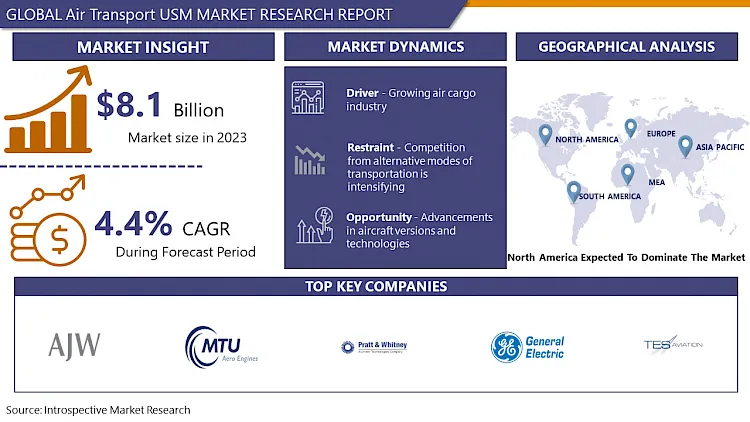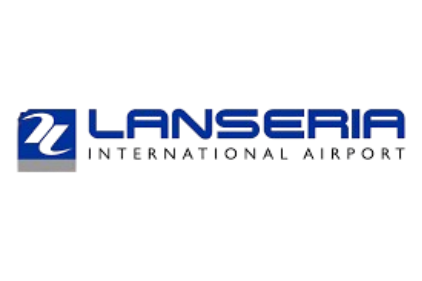Air Transport USM Market Synopsis
Air Transport USM Market Size Was Valued at USD 8.1 Billion in 2023, and is Projected to Reach USD 12.0 Billion by 2032, Growing at a CAGR of 4.4% From 2024-2032.
Used serviceable material (USM) in air transportation consists of reclaiming and repurposing intact aircraft parts and components from aging aircraft. End-users comprise airports, airlines, training facilities, and other service providers responsible for ensuring the safety and dependability of air transportation.
The aviation sector is perpetually striving to decrease its carbon emissions through various means, including the redesign of aircraft interiors, refuse disposal methods, and the implementation of more environmentally friendly disassembly and logistics processes. A maintenance facility upgrades, recertifies, tests, and inspects aircraft components that have been removed prior to their reintegration into the respective aircraft.
- The need to improve efficacy and safety, as well as technological advancements in aircraft, are significant factors propelling the air transport USM market. As avionics, engine technologies, and novel aircraft designs proliferate, so does the demand for aircraft components and services, including those provided by USM. Furthermore, the air transport USM market is anticipated to witness the emergence of fresh market prospects due to the advancement of novel air transport services, including urban air mobility. Over the course of the following decade, the air transport USM market is anticipated to expand substantially as a result of the rising demand for aircraft and associated products and services. This will present substantial prospects for businesses engaged in the manufacturing, upkeep, and restoration of USM components and services.

Air Transport USM Market Trend Analysis
Escalating air travel demand
- A number of factors contribute to the rising demand for air travel, including increased disposable incomes, enhanced global connectivity, improved air travel affordability, and increased tourism. Air travel is experiencing a surge in popularity as a transportation mode owing to its expediency and effectiveness. In response to the growing affordability of air travel among the general public, airlines have expanded their capacity to accommodate the escalating demand.
Increase in digital technology and internet penetration
- The global air transport USM market has been notably influenced by the expansion of internet penetration and digital technology. Online registration systems, digital payment systems, and other technologies are being increasingly utilized by travelers to plan and reserve flights, as internet-enabled devices proliferate. By reducing manual labor and refining processes, airlines have been able to save money and improve their operations. Further, the implementation of digital technologies empowers airlines to offer customized services and products by facilitating more precise consumer targeting.
Air Transport USM Market Segment Analysis:
Air Transport USM Market Segmented based on Product Type, Aircraft Type, and Provider Type.
By Product Type, Engine segment is expected to dominate the market during the forecast period
- In the future years, engines, components, and airframes are anticipated to experience an increase in demand for Air Transport USM (Used Serviceable Material), which is attributable to a number of additional factors. The primary impetus for airlines to explore more economical maintenance and repair solutions is the mounting pressure to decrease operational expenses. This is made possible by USM's provision of inexpensive components that maintain safety certification. Additionally, in an effort to promote a circular economy, sustainability trends in the aviation sector advocate for the implementation of more ecologically sound procedures, including the reuse and recycling of aircraft components. Further bolstering the USM market, the expansion of the worldwide aircraft fleet and the deterioration of a significant number of operational aircraft are expected to increase the need for replacement components, engines, and airframes.
- Engines are anticipated to be the most prevalent product type segment within the Air Transport USM market throughout the forecast period. Critical components, engines are expensive to produce and require lengthy lead times. Significant financial benefits accrue to airline operators from the acquisition of used, operational engines at a fraction of the price of new ones, especially in a competitive and cost-conscious market.
By Provider Type, OEM segment held the largest share of XX% in 2023
- In 2023, the OEM segment dominated the Air Transport USM market in terms of Provider Type. The ability of original equipment manufacturers (OEMs) to supply certified and dependable components instills confidence in airline operators regarding the performance and safety criteria essential for commercial aviation. In addition to their established brand reputations, extensive service networks, and the capability to provide maintenance, repair, and overhaul (MRO) integrated services, OEMs enjoy additional advantages that bolster their market standing. OEMs benefit from direct access to manufacturing and original design data, which enables them to refurbish and certify components more effectively. This extends the life of the aircraft and its critical components and ensures compatibility. These benefits establish the market dominance of OEMs and render them the preferred option for numerous airlines.
Air Transport USM Market Regional Insights:
North America is Expected to Dominate the Market Over the Forecast period
- The USM market for air transport in North America is propelled by robust economic expansion, the rise of low-cost carriers, and the rising volume of air passengers. The local market is characterized by intense competition and the participation of numerous well-established international airlines as well as lesser domestic carriers. The principal nations comprising the region are the United States, Canada, and Mexico. Due to massive investments in the sector, the United States and Canada are the most prominent aviation markets in the region and are anticipated to remain the dominant participants throughout the period of forecast.
- North America exhibited the highest global demand for USM services on account of its substantial geriatric fleet size and the presence of well-established MRO service providers in the area.
- Moreover, prominent aircraft engine manufacturers and a robust commercial aircraft industrial sector in the United States and Canada are anticipated to have a positive impact on the air transport USM market outlook for the region over the coming years.
Active Key Players in the Air Transport USM Market
- Pratt & Whitney
- TES Aviation Group
- General Electric
- AAR Corp.
- Lufthansa Technik (LHT)
- MTU Aero Engines AG
- AJ Walter Aviation Limited
- AFI KLM E&M
- GA Telesis, LLC
- Airliance Materials, LLC, and Other Key Players.
Key Industry Developments in the Air Transport USM Market:
- Pratt & Whitney announced in July 2023 that PW1100G Geared Turbo Fan engines would necessitate inspection and, if required, repair due to the discovery of a durability concern on discs within the high-pressure turbine.
- Launching the USM business segment in 2021, Boeing declared the expansion of its service portfolio.
|
Global Air Transport USM Market |
|||
|
Base Year: |
2023 |
Forecast Period: |
2024-2032 |
|
Historical Data: |
2017 to 2023 |
Market Size in 2023: |
USD 8.1 Bn. |
|
Forecast Period 2024-32 CAGR: |
4.4 % |
Market Size in 2032: |
USD 12.0 Bn. |
|
Segments Covered: |
By Product Type |
|
|
|
By Provider Type |
|
||
|
By Aircraft Type |
|
||
|
By Region |
|
||
|
Key Market Drivers: |
|
||
|
Key Market Restraints: |
|
||
|
Key Opportunities: |
|
||
|
Companies Covered in the report: |
|
||
- INTRODUCTION
- RESEARCH OBJECTIVES
- RESEARCH METHODOLOGY
- RESEARCH PROCESS
- SCOPE AND COVERAGE
- Market Definition
- Key Questions Answered
- MARKET SEGMENTATION
- EXECUTIVE SUMMARY
- MARKET OVERVIEW
- GROWTH OPPORTUNITIES BY SEGMENT
- MARKET LANDSCAPE
- PORTER’S FIVE FORCES ANALYSIS
- Bargaining Power Of Supplier
- Threat Of New Entrants
- Threat Of Substitutes
- Competitive Rivalry
- Bargaining Power Among Buyers
- INDUSTRY VALUE CHAIN ANALYSIS
- MARKET DYNAMICS
- Drivers
- Restraints
- Opportunities
- Challenges
- MARKET TREND ANALYSIS
- REGULATORY LANDSCAPE
- PESTLE ANALYSIS
- PRICE TREND ANALYSIS
- PATENT ANALYSIS
- TECHNOLOGY EVALUATION
- MARKET IMPACT OF THE RUSSIA-UKRAINE WAR
- Geopolitical Market Disruptions
- Supply Chain Disruptions
- Instability in Emerging Markets
- ECOSYSTEM
- PORTER’S FIVE FORCES ANALYSIS
- AIR TRANSPORT USM MARKET BY PRODUCT TYPE (2017-2032)
- AIR TRANSPORT USM MARKET SNAPSHOT AND GROWTH ENGINE
- MARKET OVERVIEW
- ENGINE
- Introduction And Market Overview
- Historic And Forecasted Market Size in Value (2017 – 2032F)
- Historic And Forecasted Market Size in Volume (2017 – 2032F)
- Key Market Trends, Growth Factors And Opportunities
- Geographic Segmentation Analysis
- COMPONENTS
- AIRFRAME
- AIR TRANSPORT USM MARKET BY PROVIDER TYPE (2017-2032)
- AIR TRANSPORT USM MARKET SNAPSHOT AND GROWTH ENGINE
- MARKET OVERVIEW
- OEM
- Introduction And Market Overview
- Historic And Forecasted Market Size in Value (2017 – 2032F)
- Historic And Forecasted Market Size in Volume (2017 – 2032F)
- Key Market Trends, Growth Factors And Opportunities
- Geographic Segmentation Analysis
- NON-OEM
- AIR TRANSPORT USM MARKET BY AIRCRAFT TYPE (2017-2032)
- AIR TRANSPORT USM MARKET SNAPSHOT AND GROWTH ENGINE
- MARKET OVERVIEW
- NARROWBODY JET
- Introduction And Market Overview
- Historic And Forecasted Market Size in Value (2017 – 2032F)
- Historic And Forecasted Market Size in Volume (2017 – 2032F)
- Key Market Trends, Growth Factors And Opportunities
- Geographic Segmentation Analysis
- WIDEBODY JET
- REGIONAL JET
- COMPANY PROFILES AND COMPETITIVE ANALYSIS
- COMPETITIVE LANDSCAPE
- Competitive Positioning
- Air Transport USM Market Share By Manufacturer (2023)
- Industry BCG Matrix
- Heat Map Analysis
- Mergers & Acquisitions
- PRATT & WHITNEY
- Company Overview
- Key Executives
- Company Snapshot
- Role of the Company in the Market
- Sustainability and Social Responsibility
- Operating Business Segments
- Product Portfolio
- Business Performance (Production Volume, Sales Volume, Sales Margin, Production Capacity, Capacity Utilization Rate)
- Key Strategic Moves And Recent Developments
- SWOT Analysis
- TES AVIATION GROUP
- GENERAL ELECTRIC
- AAR CORP.
- LUFTHANSA TECHNIK (LHT)
- MTU AERO ENGINES AG
- AJ WALTER AVIATION LIMITED
- AFI KLM E&M
- GA TELESIS, LLC
- AIRLIANCE MATERIALS, LLC
- COMPETITIVE LANDSCAPE
- GLOBAL AIR TRANSPORT USM MARKET BY REGION
- OVERVIEW
- NORTH AMERICA
- Key Market Trends, Growth Factors And Opportunities
- Key Manufacturers
- Historic And Forecasted Market Size By Product Type
- Historic And Forecasted Market Size By Provider Type
- Historic And Forecasted Market Size By Aircraft Type
- Historic And Forecasted Market Size By Country
- USA
- Canada
- Mexico
- EASTERN EUROPE
- Key Market Trends, Growth Factors And Opportunities
- Key Manufacturers
- Historic And Forecasted Market Size By Segments
- Historic And Forecasted Market Size By Country
- Russia
- Bulgaria
- The Czech Republic
- Hungary
- Poland
- Romania
- Rest Of Eastern Europe
- WESTERN EUROPE
- Key Market Trends, Growth Factors And Opportunities
- Key Manufacturers
- Historic And Forecasted Market Size By Segments
- Historic And Forecasted Market Size By Country
- Germany
- United Kingdom
- France
- The Netherlands
- Italy
- Spain
- Rest Of Western Europe
- ASIA PACIFIC
- Key Market Trends, Growth Factors And Opportunities
- Key Manufacturers
- Historic And Forecasted Market Size By Segments
- Historic And Forecasted Market Size By Country
- China
- India
- Japan
- South Korea
- Malaysia
- Thailand
- Vietnam
- The Philippines
- Australia
- New-Zealand
- Rest Of APAC
- MIDDLE EAST & AFRICA
- Key Market Trends, Growth Factors And Opportunities
- Key Manufacturers
- Historic And Forecasted Market Size By Segments
- Historic And Forecasted Market Size By Country
- Turkey
- Bahrain
- Kuwait
- Saudi Arabia
- Qatar
- UAE
- Israel
- South Africa
- SOUTH AMERICA
- Key Market Trends, Growth Factors And Opportunities
- Key Manufacturers
- Historic And Forecasted Market Size By Segments
- Historic And Forecasted Market Size By Country
- Brazil
- Argentina
- Rest of South America
- INVESTMENT ANALYSIS
- ANALYST VIEWPOINT AND CONCLUSION
- Recommendations and Concluding Analysis
- Potential Market Strategies
|
Global Air Transport USM Market |
|||
|
Base Year: |
2023 |
Forecast Period: |
2024-2032 |
|
Historical Data: |
2017 to 2023 |
Market Size in 2023: |
USD 8.1 Bn. |
|
Forecast Period 2024-32 CAGR: |
4.4 % |
Market Size in 2032: |
USD 12.0 Bn. |
|
Segments Covered: |
By Product Type |
|
|
|
By Provider Type |
|
||
|
By Aircraft Type |
|
||
|
By Region |
|
||
|
Key Market Drivers: |
|
||
|
Key Market Restraints: |
|
||
|
Key Opportunities: |
|
||
|
Companies Covered in the report: |
|
||
Frequently Asked Questions :
The forecast period in the Air Transport USM Market research report is 2024-2032.
Pratt & Whitney, TES Aviation Group, General Electric, AAR Corp., Lufthansa Technik (LHT), MTU Aero Engines AG, AJ Walter Aviation Limited, AFI KLM E&M, GA Telesis, LLC, Airliance Materials, LLC, and Other Major Players.
The Air Transport USM Market is segmented into Product Type, Provider Type, Aircraft Type, and region. By Product Type, the market is categorized into Engine, Components, and Airframe. By Provider type, the market is categorized into OEM and Non-OEM. By Aircraft Type, the market is categorized into Narrowbody Jet, Widebody Jet, Turboprop, and Regional Jet. By region, it is analyzed across North America (U.S.; Canada; Mexico), Europe (Germany; U.K.; France; Italy; Russia; Spain, etc.), Asia-Pacific (China; India; Japan; Southeast Asia, etc.), South America (Brazil; Argentina, etc.), Middle East & Africa (Saudi Arabia; South Africa, etc.).
Parts and components of decommissioned or non-operational aircraft that are salvaged, refurbished, and repurposed for use in operational aircraft constitute the practice of used serviceable material (USM) in air transport, which is an efficiency and sustainability strategy. This method assists airlines and maintenance providers in cost management while simultaneously decreasing waste and the need for replacement parts. In order to maintain the integrity and safety of the aircraft in which they are deployed, USM must adhere to stringent operational and safety objectives. The aviation industry maintains high safety standards, reduces expenses, and benefits the environment with this system.
Air Transport USM Market Size Was Valued at USD 8.1 Billion in 2023, and is Projected to Reach USD 12.0 Billion by 2032, Growing at a CAGR of 4.4% From 2024-2032.








